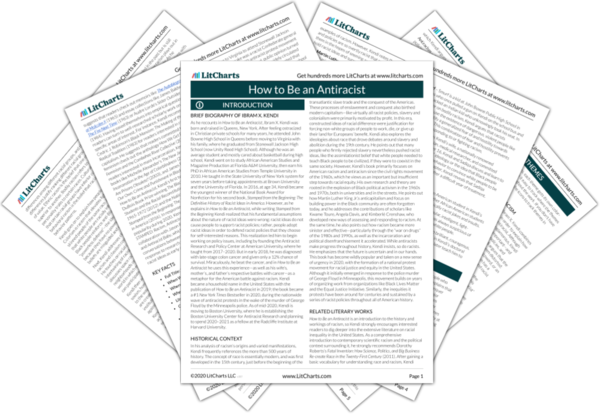In How to Be an Antiracist, Dr. Ibram X. Kendi presents a theory of antiracism, a system of ideas and policies that fight racial inequity. As teenager, Kendi gave a public speech full of stereotypes about young Black people like himself. Although the audience loved it, Kendi now understands how misguided he was: he blamed people for racial inequities that were really caused by policy. In turn, he implied that Black people—including himself—were inherently inferior to other groups. This kind of thinking is the essence of racism.
Kendi argues that there’s no such thing as being “not racist”—a person is either racist or actively antiracist. There’s no neutral middle ground between equality and inequality. Virtually everyone believes in some racist ideas, and racism is not always conscious. But it’s also not inevitable: people can always unlearn their racism and become antiracist. Kendi uses himself as an example: he was an anti-Black racist, then an anti-white racist, before he finally became an antiracist. Kendi defines racism as a system comprised of three main components: racial inequities; the racist policies that create these inequities; and the racist ideas that justify these policies. In contrast, antiracism is a set of antiracist policies, justified by antiracist ideas, that produces racial equity.

Next, Kendi compares antiracism to segregationism and assimilationism, two common political stances that have failed to produce racial equity. Segregationists believe that racial groups should be divided because some are inherently superior to others. Assimilationists agree that certain groups are superior to others but think that inferior groups can be improved if they become more like the dominant group. When it comes to race, Kendi argues that most Americans face what he calls dueling consciousness: Black Americans get stuck between assimilationism and antiracism, while white Americans often struggle to choose between segregationism and assimilationism. Kendi then looks at the history of race, which is not a real scientific category. Rather, it is a system of categorization that powerful people developed throughout history in order to divide and conquer other groups.
Kendi then outlines the main types of racist ideas: biological racism is the idea that there are meaningful biological differences among different racial groups, and that these differences justify ranking different racial groups in a hierarchy of value. Ethnic racism is the belief that one ethnic group is superior to another. Bodily racism refers to attaching personality traits to certain races. Cultural racism is the idea that certain racial groups have inferior cultures. Finally, behavioral racism is the belief that racial groups have different behavior patterns.
Kendi goes on to explain how people of color can be racist. Colorism is racism that elevates light-skinned over dark-skinned people of the same race. Anti-white racism is the idea that white people are racially inferior to people of color. Finally, Black people reinforce anti-Black racism through the “powerless defense”—the idea that Black people can’t be racist because they have no power. Kendi argues that all of these beliefs are misguided and counterproductive to antiracism.
Next, Kendi addresses class racism, which is the idea that racism and classism combine to oppress poor people of color. He touches on racial capitalism, which refers to the historical intertwining of racist and capitalist polices. Kendi then discusses space racism, or the racialization of spaces like neighborhoods or institutions. Kendi imagines an antiracist world in which every group has its own spaces, and everyone can participate in any of them.
Kendi then addresses the intersectionality between racism and sexism, homophobia, and transphobia. Intersectionality refers to the way that different forms of inequity work together: they are created by the same powerful, self-interested people and institutions, and they overlap. He concludes that all movements against all kinds of inequity must be linked.
Kendi ends the book by analyzing how antiracist activism can achieve social change. He emphasizes that racism comes from self-interest, not ignorance—which means that fighting it requires power, not just knowledge. In his concluding chapter, Kendi reveals that he, his mom, his dad, and his wife Sadiqa are all cancer survivors, and he uses their fight as a metaphor for America’s fight against racism. He argues that antiracists have to understand that the odds are against them—but that they must hold onto compassion and hope. Otherwise, antiracists can never build a more just and equitable world.







